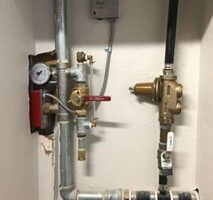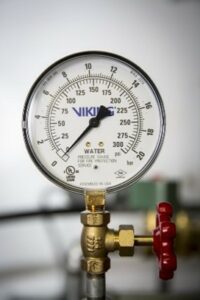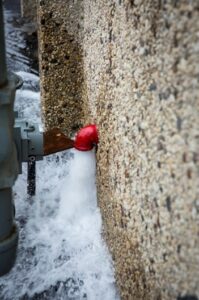Main Drain Tests for Fire Sprinkler Systems

Most of us who handle fire sprinkler inspections know that main drain tests are required. In this blog we will discuss the requirements of the main drain test.
What is the difference between the main drain connection and main drain test connection?
Let us first look at what the difference between a main drain connection and a main drain test connection. A main drain connection is used to drain the fire protection system and is located at the system riser. A main drain test connection is the same connection as the main drain connection but is used to conduct a main drain test. Confusing? Maybe a little, but the reason for the difference in the wording is specifically cited in Section 16.10.4.6 of NFPA 13, 2019 edition. This section states that the main drain test connection shall be installed so that the valve can be opened wide for a sufficient amount of time to conduct a main drain test. This may seem trivial and common sense however, many times the main drain test cannot be conducted because the main drain is not installed properly to conduct the main drain test. In many cases the main drain test connection is not piped to a proper drain or to the exterior of the building.

The main drain test is conducted to determine if there is degradation in the water supply from the original acceptance test. NFPA 25, Section 13.2.3.3 states that when there is a reduction of ten percent of full flow an investigation shall be conducted to determine the reason.
There is always some discussion of what the results of the current main drain test should be compared to. Section 13.2.3.3 states that the results shall be compared to the original acceptance test or previous tests. This can be a bit confusing and to add to the confusion, Section 4.6.4 states that all test results shall be compared to the original acceptance tests and previous test results. So one section says or and the other section says and. To clarify this, if possible, all flow test results should be compared to the original acceptance tests AND previous tests.  The reason for this is to determine if there is a degradation of the water supply from installation. The main drain test can also identify if there is partially closed valves or other blockages in the piping. It should be noted that Section 4.3 requires owner is required to have all of the original acceptance results for the life of the system and is citable if they do not.
The reason for this is to determine if there is a degradation of the water supply from installation. The main drain test can also identify if there is partially closed valves or other blockages in the piping. It should be noted that Section 4.3 requires owner is required to have all of the original acceptance results for the life of the system and is citable if they do not.
How often is a main drain test required?
Great question, and often is answered differently. The easy answer is that the main drain test is required annually unless the sole water supply is through a backflow preventer or pressure reducing valve, then the test is required quarterly. This does not necessarily mean that a test must be completed at every riser. Section 13.2.3.1 states that if there are multiple risers on a single manifold then the test only has to be completed on a single riser however, if there are several individual risers then the test must be completed at each riser. Section 13.2.3.2 states that where the water supply is through a backflow then one system down stream must tested quarterly. An example would be if in a building with multiple risers in different locations and they all are fed through the same backflow preventer or pressure reducing valve, then only one of the systems are required to have a main drain test conducted quarterly. The reason for the quarterly test requirement is not necessarily to verify the water supply but to exercise the components in the backflow and/or the pressure reducing valve.

The main reason for conducting any testing required by NFPA 25 is to determine how the system operates now as compared to the day it was installed. In the end the main drain test is very important in determining that the water supply is not deteriorating, and the sprinkler system should operate as designed. Section 4.6.1 states that all system components shall be tested to verify they operate as intended, this includes the main drain test connection.
